© Copyright Atlanta Coin Expositions, 2008-2025. All Rights Reserved.
Several of the links on the pages within this web site go to affiliate vendors.
A vendor affiliation can mean a small monetary compensation to the web site owner at no additional cost to you.
Several of the links on the pages within this web site go to affiliate vendors.
A vendor affiliation can mean a small monetary compensation to the web site owner at no additional cost to you.
Coin Show
Information
Shop
General
Next Monthly Coin Show
Coin Show - Monthly Notes for October 2022
Mark your calendar and join us at the next show on Sunday, November 6, 2022, in the Joe Mack Wilson ballroom.
Once again, dealers will pack the ballroom with their showcases of coins, currency, bullion, exonumia, scripophily, semi-precious stones, jewelry and other interesting items.
Guests visiting the show are welcome to buy, sell, trade or just view the history found in the many displays. People can also bring coins and currency to the show for a free verbal appraisal of the items in the current market.
The show is open from 9am - 5pm, however the most dealers and opportunities are available between 10am and 2pm.
Should circumstances impact the show, check with this web site, the recorded show message (770-772-4359) or join our mailing list to receive information about the shows.
Make a reminder note and visit the next Greater Atlanta Coin Show on Sunday, November 6, 2022 in the Joe Mack Wilson ballroom to join the fun and view the items on the bourse.
Once again, dealers will pack the ballroom with their showcases of coins, currency, bullion, exonumia, scripophily, semi-precious stones, jewelry and other interesting items.
Guests visiting the show are welcome to buy, sell, trade or just view the history found in the many displays. People can also bring coins and currency to the show for a free verbal appraisal of the items in the current market.
The show is open from 9am - 5pm, however the most dealers and opportunities are available between 10am and 2pm.
Should circumstances impact the show, check with this web site, the recorded show message (770-772-4359) or join our mailing list to receive information about the shows.
Make a reminder note and visit the next Greater Atlanta Coin Show on Sunday, November 6, 2022 in the Joe Mack Wilson ballroom to join the fun and view the items on the bourse.
2013 Five-Star Generals Commemorative Gold Five-Dollar Coin
1835 Half Dime Coin
1917 Standing Liberty Quarter Dollar Coin
1950 Franklin Half Dollar Coin
The October 2022 Greater Atlanta Coin Show welcomed many guests to the bourse filled with dealers and their showcases of coins, currency, bullion and other collectibles.
We appreciate each of you from our visitors to our dealers to our security and to the hotel's staff for helping make the show a fun and interesting place to spend a few hours one Sunday each month. Here's a big THANK YOU to all of you.
As an aside, a special thank you goes to the many visitors who encountered road construction on the interstate system in the area yet still came to the show.
Please note, it's best to arrive at the show early in the day. Several of our dealers have long drives or Sunday evening plans and leave by mid-afternoon.
We appreciate each of you from our visitors to our dealers to our security and to the hotel's staff for helping make the show a fun and interesting place to spend a few hours one Sunday each month. Here's a big THANK YOU to all of you.
As an aside, a special thank you goes to the many visitors who encountered road construction on the interstate system in the area yet still came to the show.
Please note, it's best to arrive at the show early in the day. Several of our dealers have long drives or Sunday evening plans and leave by mid-afternoon.
The show welcomes guests who are interested in buying, selling, trading or just viewing the many items on display including coins, currency, bullion and other collectibles. Of course, admission is always free.
The show's dealers also offer free verbal appraisals based on current market values for numismatic items brought to the show for evaluation.
Dealers at the show provide a wealth of experience along with the wide variety of displays from ancient to modern, from historical to current, from loose good to slabbed mint state, from coins to currency to bullion to medals to stock certificates to jewelry to other types of interesting items.
The show's dealers also offer free verbal appraisals based on current market values for numismatic items brought to the show for evaluation.
Dealers at the show provide a wealth of experience along with the wide variety of displays from ancient to modern, from historical to current, from loose good to slabbed mint state, from coins to currency to bullion to medals to stock certificates to jewelry to other types of interesting items.
For the October show, the weather presented a nice fall day with a mix of overcast and sunny skies with temperatures in the low 70s. Though some trees still held on to green leaves, others presented their fall colors of red, yellow, gold and orange. Not too many have fallen for early October, but soon they will drop their colors.
One of the topics among people on the bourse discussed the US Mint's cut in production to their bullion distributors for the remainder of 2022. Rumor has it all distributor requests were cut in half.
Is the production cut due to work force and equipment issues or is it due to lack of raw product?
On a related note, many dealers are having difficulty finding gold and silver bullion. Several brought 90% silver to sell since they could not find silver rounds or bars.
Now, let's take a look at some gold and silver items seen at the show.
One of the topics among people on the bourse discussed the US Mint's cut in production to their bullion distributors for the remainder of 2022. Rumor has it all distributor requests were cut in half.
Is the production cut due to work force and equipment issues or is it due to lack of raw product?
On a related note, many dealers are having difficulty finding gold and silver bullion. Several brought 90% silver to sell since they could not find silver rounds or bars.
Now, let's take a look at some gold and silver items seen at the show.
Our first item this month is a gold five-dollar coin from 2013.
That year, the US Mint produced three commemorative coins honoring five-star generals from a clad quarter to a silver dollar to the gold five-dollar coin.
The coins’ release coincided with the celebration of the 132nd anniversary of the founding of the United States Army Command and General Staff College (CGSC). The generals honored on the three coins either attended or taught at CGSC.
The 5-Star Generals Commemorative Coin Act (Public Law 111-262) authorized the mint to strike and issue up to 100,000 of the commemorative five-dollar coins.
In reality, the Mint produced less than 6000 of the uncirculated gold coins and just under 16,000 of the proof gold coins.
The mintage numbers are not the lowest of the commemorative gold five-dollar coins, however the small quantity could add value to the coin as a collectible over time.
That year, the US Mint produced three commemorative coins honoring five-star generals from a clad quarter to a silver dollar to the gold five-dollar coin.
The coins’ release coincided with the celebration of the 132nd anniversary of the founding of the United States Army Command and General Staff College (CGSC). The generals honored on the three coins either attended or taught at CGSC.
The 5-Star Generals Commemorative Coin Act (Public Law 111-262) authorized the mint to strike and issue up to 100,000 of the commemorative five-dollar coins.
In reality, the Mint produced less than 6000 of the uncirculated gold coins and just under 16,000 of the proof gold coins.
The mintage numbers are not the lowest of the commemorative gold five-dollar coins, however the small quantity could add value to the coin as a collectible over time.
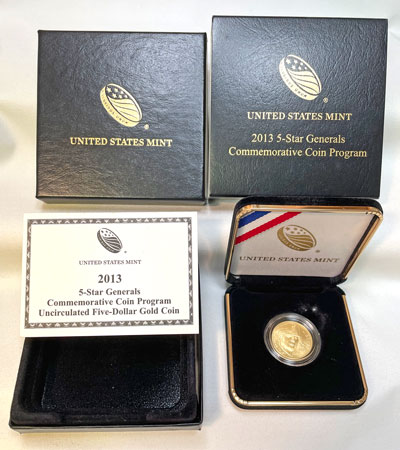
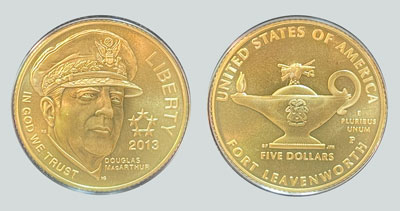
The obverse design features a portrait of General Douglas MacArthur with the 5-star insignia on the right side of the design.
Inscriptions are IN GOD WE TRUST, DOUGLAS MACARTHUR, 2013 and LIBERTY.
United States Mint Artistic Infusion Program (AIP) Associate Designer Ronald D. Sanders designed the obverse, and United States Mint Sculptor-Engraver Michael Gaudiso executed the design.
The reverse design features the Leavenworth Lamp, the symbol of the CGSC.
Inscriptions are IN GOD WE TRUST, DOUGLAS MACARTHUR, 2013 and LIBERTY.
United States Mint Artistic Infusion Program (AIP) Associate Designer Ronald D. Sanders designed the obverse, and United States Mint Sculptor-Engraver Michael Gaudiso executed the design.
The reverse design features the Leavenworth Lamp, the symbol of the CGSC.
Inscriptions are UNITED STATES OF AMERICA, E PLURIBUS UNUM, FIVE DOLLARS and FORT LEAVENWORTH.
AIP Master Designer Barbara Fox designed the reverse, and United States Mint Sculptor-Engraver Joseph Menna produced the design.
This coin and the others in the five-star generals set remembers and recognizes men who exhibited bravery and leadership during a difficult time in history.
AIP Master Designer Barbara Fox designed the reverse, and United States Mint Sculptor-Engraver Joseph Menna produced the design.
This coin and the others in the five-star generals set remembers and recognizes men who exhibited bravery and leadership during a difficult time in history.
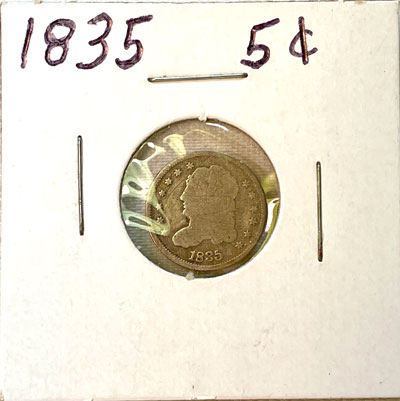
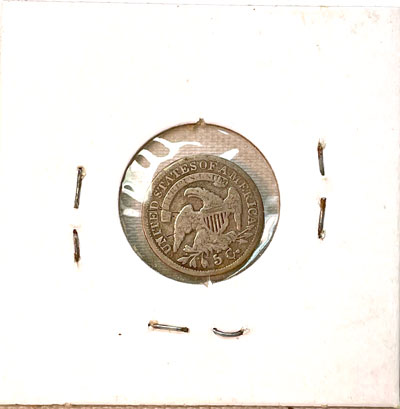
Our next coin comes from the 19th century.
The US Mint began making half dimes in 1792, the first of which was the half disme.
Though not produced every year, the half dime production continued until its last year in 1873.
At that time Congress chose to revisit the nation's coinage production. They discontinued the silver half dime coins in favor of the nickel five-cent coins.
Interestingly, we think of our older silver coins as being 90% silver, but that was not the case with the early half dimes.
The first half dimes weighed 1.35 grams, was 16.5 mm in diameter and contained 0.8924 silver and 0.1076 copper.
In 1829, the diameter changed to 15.5 mm but the weight and content stayed the same.
The US Mint began making half dimes in 1792, the first of which was the half disme.
Though not produced every year, the half dime production continued until its last year in 1873.
At that time Congress chose to revisit the nation's coinage production. They discontinued the silver half dime coins in favor of the nickel five-cent coins.
Interestingly, we think of our older silver coins as being 90% silver, but that was not the case with the early half dimes.
The first half dimes weighed 1.35 grams, was 16.5 mm in diameter and contained 0.8924 silver and 0.1076 copper.
In 1829, the diameter changed to 15.5 mm but the weight and content stayed the same.
In 1837, the weight changed to 1.34 grams with 0.900 silver and 0.100 copper content.
This coin from 1835 is one of four different die pairings.
There is a large date and large 5C, a large date and small 5C, a small date and large 5C, and a small date and small 5C.
The date is on the obverse, and the 5C is on the reverse.
This particular coin appear to be a large date and small 5C variety.
But, per the 2023 Red Book, the values remain the same for all the varieties across all the grades.
This coin could tell us lots of history as it appears to be well traveled.
It's an interesting specimen from the early years of our coinage.
This coin from 1835 is one of four different die pairings.
There is a large date and large 5C, a large date and small 5C, a small date and large 5C, and a small date and small 5C.
The date is on the obverse, and the 5C is on the reverse.
This particular coin appear to be a large date and small 5C variety.
But, per the 2023 Red Book, the values remain the same for all the varieties across all the grades.
This coin could tell us lots of history as it appears to be well traveled.
It's an interesting specimen from the early years of our coinage.
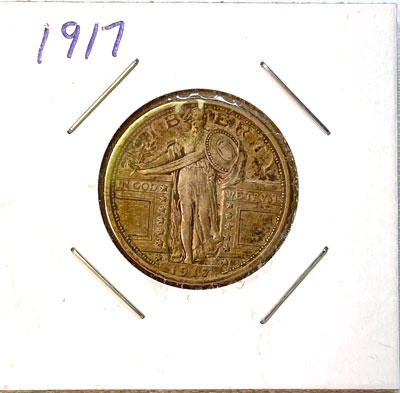
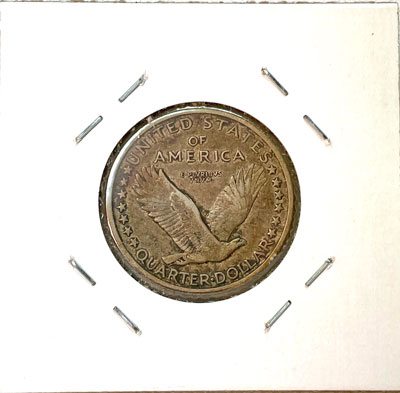
The US Mint began minting the Standing Liberty Quarter Coin in 1916, however the first full year of production began in 1917.
Herman A. MacNeil designed the Standing Liberty Quarter Coin. Due to feedback on the initial design, he made change during 1917.
He added chain mail to Liberty's naked breast. He also moved the eagle on the reverse to a more centered position and moved three of the thirteen stars to below the eagle.
Mr. MacNeil's initial can be seen to the right of the date and the lowest star on the coin's obverse.
This 1917 specimen includes Liberty's naked breast and does not include modified eagle and re-positioned stars on the reverse.
Per Ron Guth from the Professional Coin Grading Service (PCGS) CoinFacts:
Herman A. MacNeil designed the Standing Liberty Quarter Coin. Due to feedback on the initial design, he made change during 1917.
He added chain mail to Liberty's naked breast. He also moved the eagle on the reverse to a more centered position and moved three of the thirteen stars to below the eagle.
Mr. MacNeil's initial can be seen to the right of the date and the lowest star on the coin's obverse.
This 1917 specimen includes Liberty's naked breast and does not include modified eagle and re-positioned stars on the reverse.
Per Ron Guth from the Professional Coin Grading Service (PCGS) CoinFacts:
"Well struck examples are the most desirable and much attention is focused on Liberty's head.
"So-called "Full Head" examples (those with complete details) often bring considerable premiums over poorly struck examples, but attention should also be paid to the rivets on the shield."
This example certainly has all the rivets in the shield. Unfortunately, the glare on the coin holder hides the details on Liberty's head.
The population for this 1917 coin produced in Philadelphia was over 8.7 million.
Today, PCGS estimates 25,000 of the coins have survived over the last 100+ years across all grades.
This surviving coin certainly displays Mr. MacNeil's early design, and the toning helps show off the details.
"So-called "Full Head" examples (those with complete details) often bring considerable premiums over poorly struck examples, but attention should also be paid to the rivets on the shield."
This example certainly has all the rivets in the shield. Unfortunately, the glare on the coin holder hides the details on Liberty's head.
The population for this 1917 coin produced in Philadelphia was over 8.7 million.
Today, PCGS estimates 25,000 of the coins have survived over the last 100+ years across all grades.
This surviving coin certainly displays Mr. MacNeil's early design, and the toning helps show off the details.
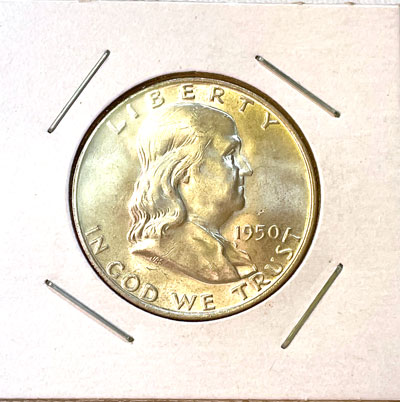

Our last example for this month is a more modern coin yet not one that is in circulation today.
The US Mint began producing the half dollar coin in 1794. With many design changes through the years, the Mint continues to strike the half collar coin today though it is rarely seen in circulation.
In 1948, the US Mint began producing the Franklin half dollar coin and continued production through 1963.
This 1950 Franklin half dollar coin is one of over 7.7 million struck at the Philadelphia Mint.
Today, PCGS estimates ten percent of the 1950 Philadelphia Franklin half dollar coins have survived across all grades.
John R. Sinnock, chief engraver of the Philadelphia Mint, designed the new Franklin half dollar replacing the Liberty Walking coin design, which began in 1916.
The US Mint began producing the half dollar coin in 1794. With many design changes through the years, the Mint continues to strike the half collar coin today though it is rarely seen in circulation.
In 1948, the US Mint began producing the Franklin half dollar coin and continued production through 1963.
This 1950 Franklin half dollar coin is one of over 7.7 million struck at the Philadelphia Mint.
Today, PCGS estimates ten percent of the 1950 Philadelphia Franklin half dollar coins have survived across all grades.
John R. Sinnock, chief engraver of the Philadelphia Mint, designed the new Franklin half dollar replacing the Liberty Walking coin design, which began in 1916.
The small eagle to the right of the Liberty bell on the reverse satisfied the requirement of the Coinage Act of 1792 that an eagle appear on the reverse of all silver coins. Though there were a few exemptions through the years.
When newly introduced, many criticized the Franklin design, perhaps thinking the design rather plain after the Liberty Walking coin.
More recently, the Franklin half dollars are popular pieces and are highly desired by both collectors and investors in 90% silver.
This specimen is interesting in that the obverse appears to be a beautiful almost uncirculated coin while the reverse also appears to have all the significant details but with heavy toning.
Remember, many collectors find toning very appealing.
Whether looking at the obverse or the reverse, this coin is a nice example of the early Franklin half dollar coins.
When newly introduced, many criticized the Franklin design, perhaps thinking the design rather plain after the Liberty Walking coin.
More recently, the Franklin half dollars are popular pieces and are highly desired by both collectors and investors in 90% silver.
This specimen is interesting in that the obverse appears to be a beautiful almost uncirculated coin while the reverse also appears to have all the significant details but with heavy toning.
Remember, many collectors find toning very appealing.
Whether looking at the obverse or the reverse, this coin is a nice example of the early Franklin half dollar coins.
